Leader Traits: Examining Key Qualities for Success in Leadership Role
VerifiedAdded on 2023/03/30
|8
|1519
|343
Essay
AI Summary
This essay delves into the traits that define effective leaders, emphasizing that leadership effectiveness is not solely innate but also shaped by situational adaptability. It analyzes the leadership styles of Indra Nooyi, former CEO of PepsiCo, as a transformational and visionary leader known for honesty, integrity, and a focus on inclusive growth, and Jeff Bezos, CEO of Amazon, known for his customer-centric approach and high expectations. The essay underscores the importance of communication, relationship-building, ethical conduct, and vision in successful leadership. Ultimately, it concludes that while certain traits like charisma and intelligence are beneficial, leaders are primarily made through experience, adaptability, and a commitment to inspiring and motivating their followers, suggesting that effective leadership balances inherent qualities with learned skills and situational awareness. Desklib provides a platform for students to access similar essays and study resources.
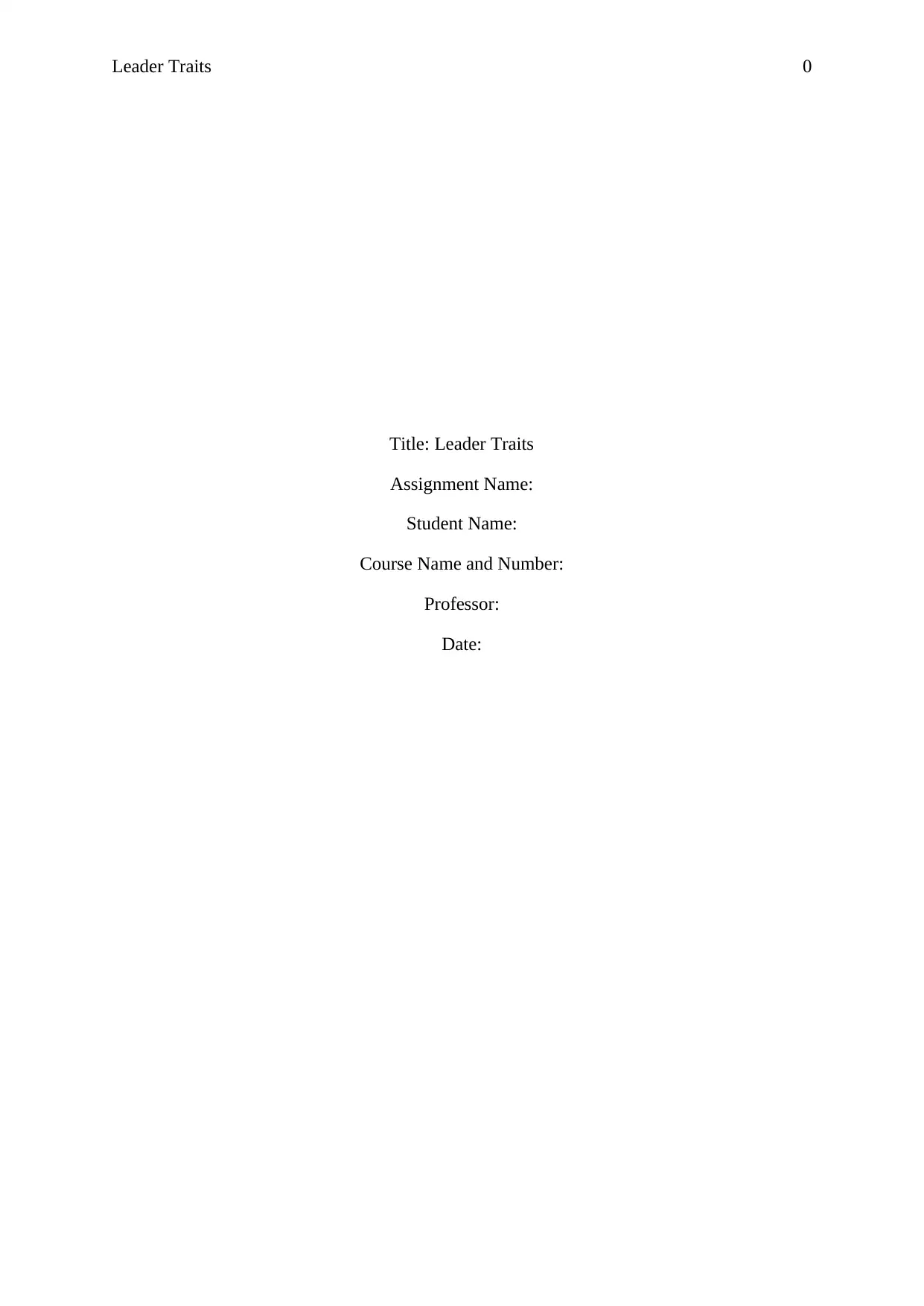
Leader Traits 0
Title: Leader Traits
Assignment Name:
Student Name:
Course Name and Number:
Professor:
Date:
Title: Leader Traits
Assignment Name:
Student Name:
Course Name and Number:
Professor:
Date:
Paraphrase This Document
Need a fresh take? Get an instant paraphrase of this document with our AI Paraphraser
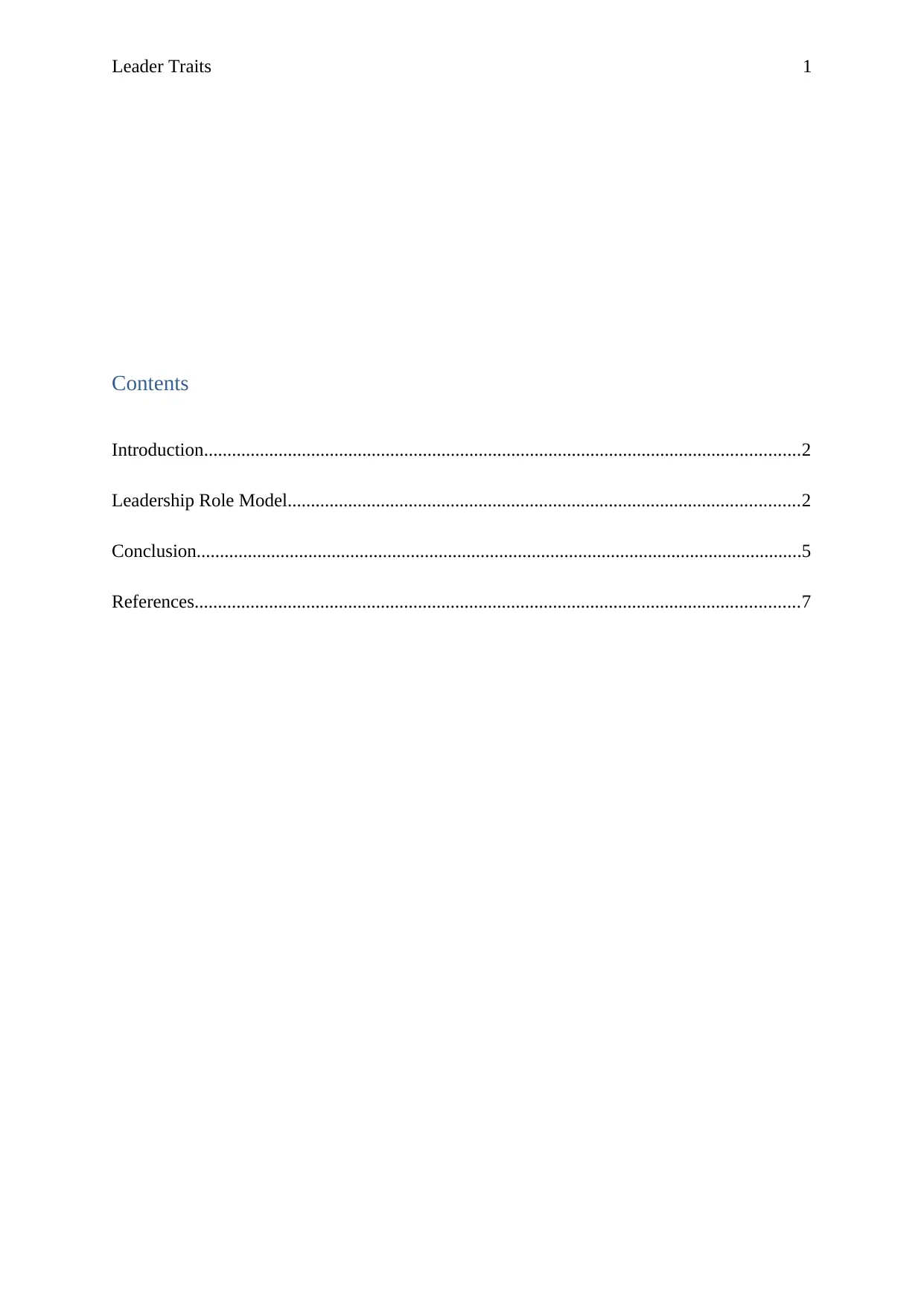
Leader Traits 1
Contents
Introduction................................................................................................................................2
Leadership Role Model..............................................................................................................2
Conclusion..................................................................................................................................5
References..................................................................................................................................7
Contents
Introduction................................................................................................................................2
Leadership Role Model..............................................................................................................2
Conclusion..................................................................................................................................5
References..................................................................................................................................7
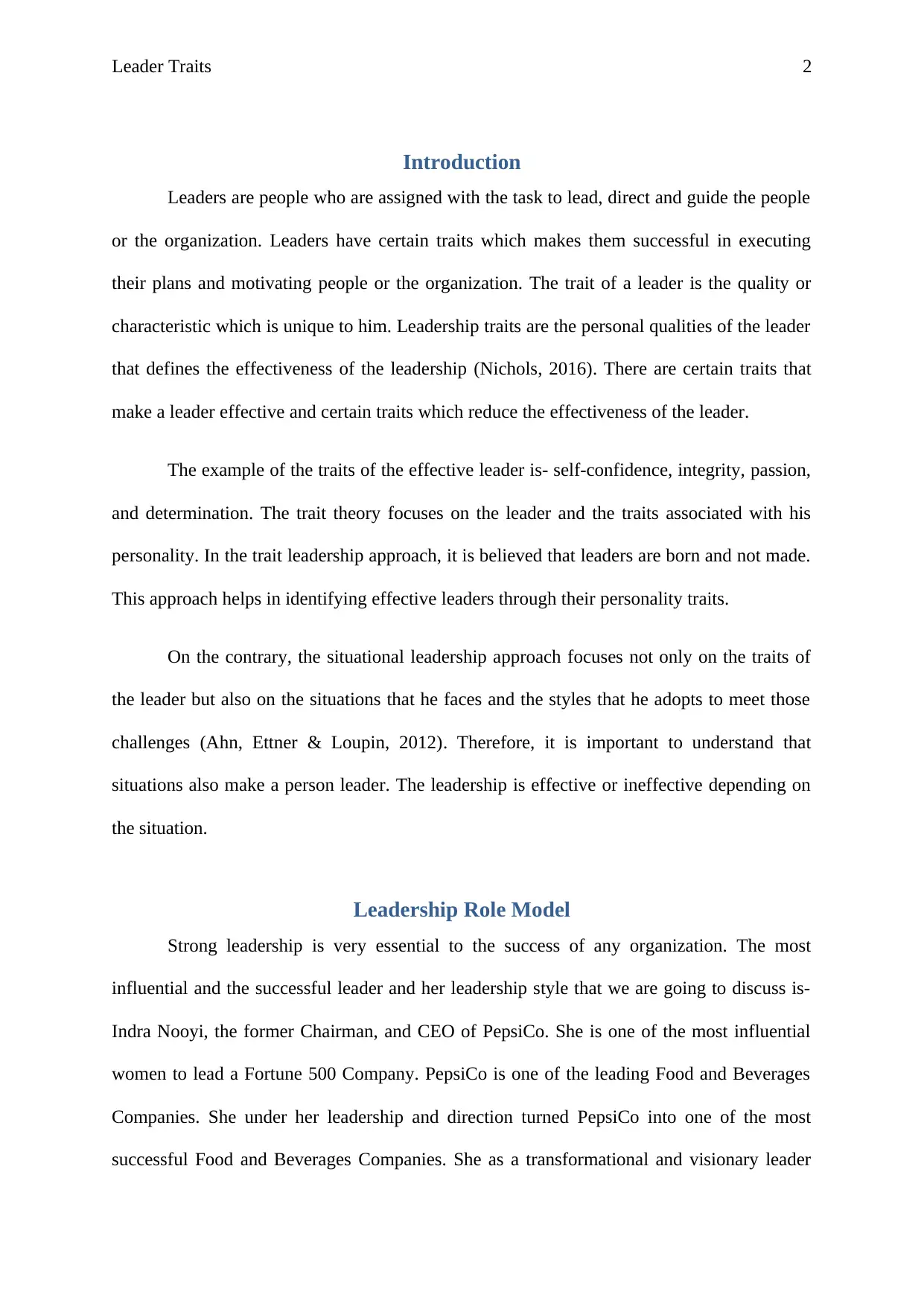
Leader Traits 2
Introduction
Leaders are people who are assigned with the task to lead, direct and guide the people
or the organization. Leaders have certain traits which makes them successful in executing
their plans and motivating people or the organization. The trait of a leader is the quality or
characteristic which is unique to him. Leadership traits are the personal qualities of the leader
that defines the effectiveness of the leadership (Nichols, 2016). There are certain traits that
make a leader effective and certain traits which reduce the effectiveness of the leader.
The example of the traits of the effective leader is- self-confidence, integrity, passion,
and determination. The trait theory focuses on the leader and the traits associated with his
personality. In the trait leadership approach, it is believed that leaders are born and not made.
This approach helps in identifying effective leaders through their personality traits.
On the contrary, the situational leadership approach focuses not only on the traits of
the leader but also on the situations that he faces and the styles that he adopts to meet those
challenges (Ahn, Ettner & Loupin, 2012). Therefore, it is important to understand that
situations also make a person leader. The leadership is effective or ineffective depending on
the situation.
Leadership Role Model
Strong leadership is very essential to the success of any organization. The most
influential and the successful leader and her leadership style that we are going to discuss is-
Indra Nooyi, the former Chairman, and CEO of PepsiCo. She is one of the most influential
women to lead a Fortune 500 Company. PepsiCo is one of the leading Food and Beverages
Companies. She under her leadership and direction turned PepsiCo into one of the most
successful Food and Beverages Companies. She as a transformational and visionary leader
Introduction
Leaders are people who are assigned with the task to lead, direct and guide the people
or the organization. Leaders have certain traits which makes them successful in executing
their plans and motivating people or the organization. The trait of a leader is the quality or
characteristic which is unique to him. Leadership traits are the personal qualities of the leader
that defines the effectiveness of the leadership (Nichols, 2016). There are certain traits that
make a leader effective and certain traits which reduce the effectiveness of the leader.
The example of the traits of the effective leader is- self-confidence, integrity, passion,
and determination. The trait theory focuses on the leader and the traits associated with his
personality. In the trait leadership approach, it is believed that leaders are born and not made.
This approach helps in identifying effective leaders through their personality traits.
On the contrary, the situational leadership approach focuses not only on the traits of
the leader but also on the situations that he faces and the styles that he adopts to meet those
challenges (Ahn, Ettner & Loupin, 2012). Therefore, it is important to understand that
situations also make a person leader. The leadership is effective or ineffective depending on
the situation.
Leadership Role Model
Strong leadership is very essential to the success of any organization. The most
influential and the successful leader and her leadership style that we are going to discuss is-
Indra Nooyi, the former Chairman, and CEO of PepsiCo. She is one of the most influential
women to lead a Fortune 500 Company. PepsiCo is one of the leading Food and Beverages
Companies. She under her leadership and direction turned PepsiCo into one of the most
successful Food and Beverages Companies. She as a transformational and visionary leader
⊘ This is a preview!⊘
Do you want full access?
Subscribe today to unlock all pages.

Trusted by 1+ million students worldwide
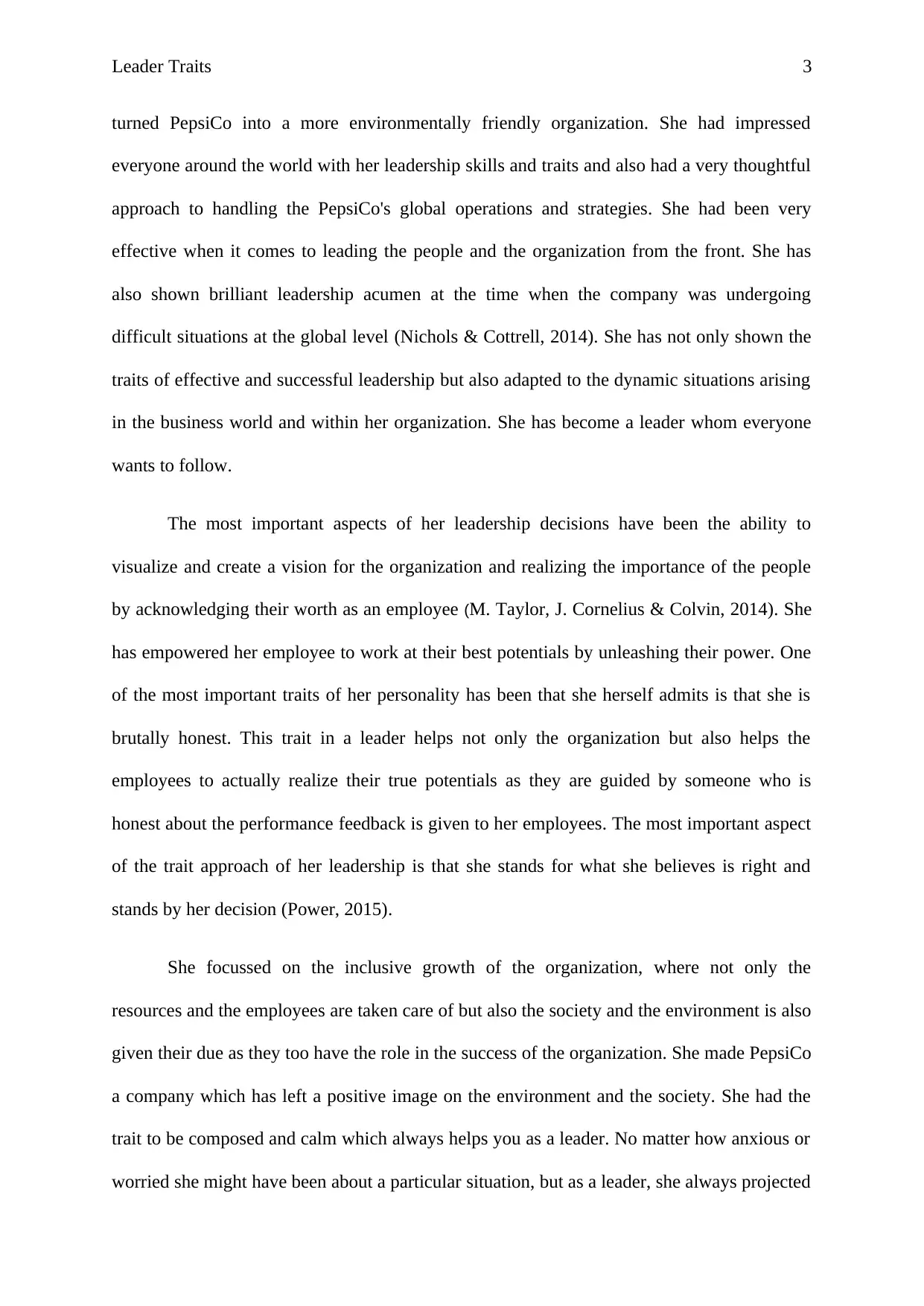
Leader Traits 3
turned PepsiCo into a more environmentally friendly organization. She had impressed
everyone around the world with her leadership skills and traits and also had a very thoughtful
approach to handling the PepsiCo's global operations and strategies. She had been very
effective when it comes to leading the people and the organization from the front. She has
also shown brilliant leadership acumen at the time when the company was undergoing
difficult situations at the global level (Nichols & Cottrell, 2014). She has not only shown the
traits of effective and successful leadership but also adapted to the dynamic situations arising
in the business world and within her organization. She has become a leader whom everyone
wants to follow.
The most important aspects of her leadership decisions have been the ability to
visualize and create a vision for the organization and realizing the importance of the people
by acknowledging their worth as an employee (M. Taylor, J. Cornelius & Colvin, 2014). She
has empowered her employee to work at their best potentials by unleashing their power. One
of the most important traits of her personality has been that she herself admits is that she is
brutally honest. This trait in a leader helps not only the organization but also helps the
employees to actually realize their true potentials as they are guided by someone who is
honest about the performance feedback is given to her employees. The most important aspect
of the trait approach of her leadership is that she stands for what she believes is right and
stands by her decision (Power, 2015).
She focussed on the inclusive growth of the organization, where not only the
resources and the employees are taken care of but also the society and the environment is also
given their due as they too have the role in the success of the organization. She made PepsiCo
a company which has left a positive image on the environment and the society. She had the
trait to be composed and calm which always helps you as a leader. No matter how anxious or
worried she might have been about a particular situation, but as a leader, she always projected
turned PepsiCo into a more environmentally friendly organization. She had impressed
everyone around the world with her leadership skills and traits and also had a very thoughtful
approach to handling the PepsiCo's global operations and strategies. She had been very
effective when it comes to leading the people and the organization from the front. She has
also shown brilliant leadership acumen at the time when the company was undergoing
difficult situations at the global level (Nichols & Cottrell, 2014). She has not only shown the
traits of effective and successful leadership but also adapted to the dynamic situations arising
in the business world and within her organization. She has become a leader whom everyone
wants to follow.
The most important aspects of her leadership decisions have been the ability to
visualize and create a vision for the organization and realizing the importance of the people
by acknowledging their worth as an employee (M. Taylor, J. Cornelius & Colvin, 2014). She
has empowered her employee to work at their best potentials by unleashing their power. One
of the most important traits of her personality has been that she herself admits is that she is
brutally honest. This trait in a leader helps not only the organization but also helps the
employees to actually realize their true potentials as they are guided by someone who is
honest about the performance feedback is given to her employees. The most important aspect
of the trait approach of her leadership is that she stands for what she believes is right and
stands by her decision (Power, 2015).
She focussed on the inclusive growth of the organization, where not only the
resources and the employees are taken care of but also the society and the environment is also
given their due as they too have the role in the success of the organization. She made PepsiCo
a company which has left a positive image on the environment and the society. She had the
trait to be composed and calm which always helps you as a leader. No matter how anxious or
worried she might have been about a particular situation, but as a leader, she always projected
Paraphrase This Document
Need a fresh take? Get an instant paraphrase of this document with our AI Paraphraser
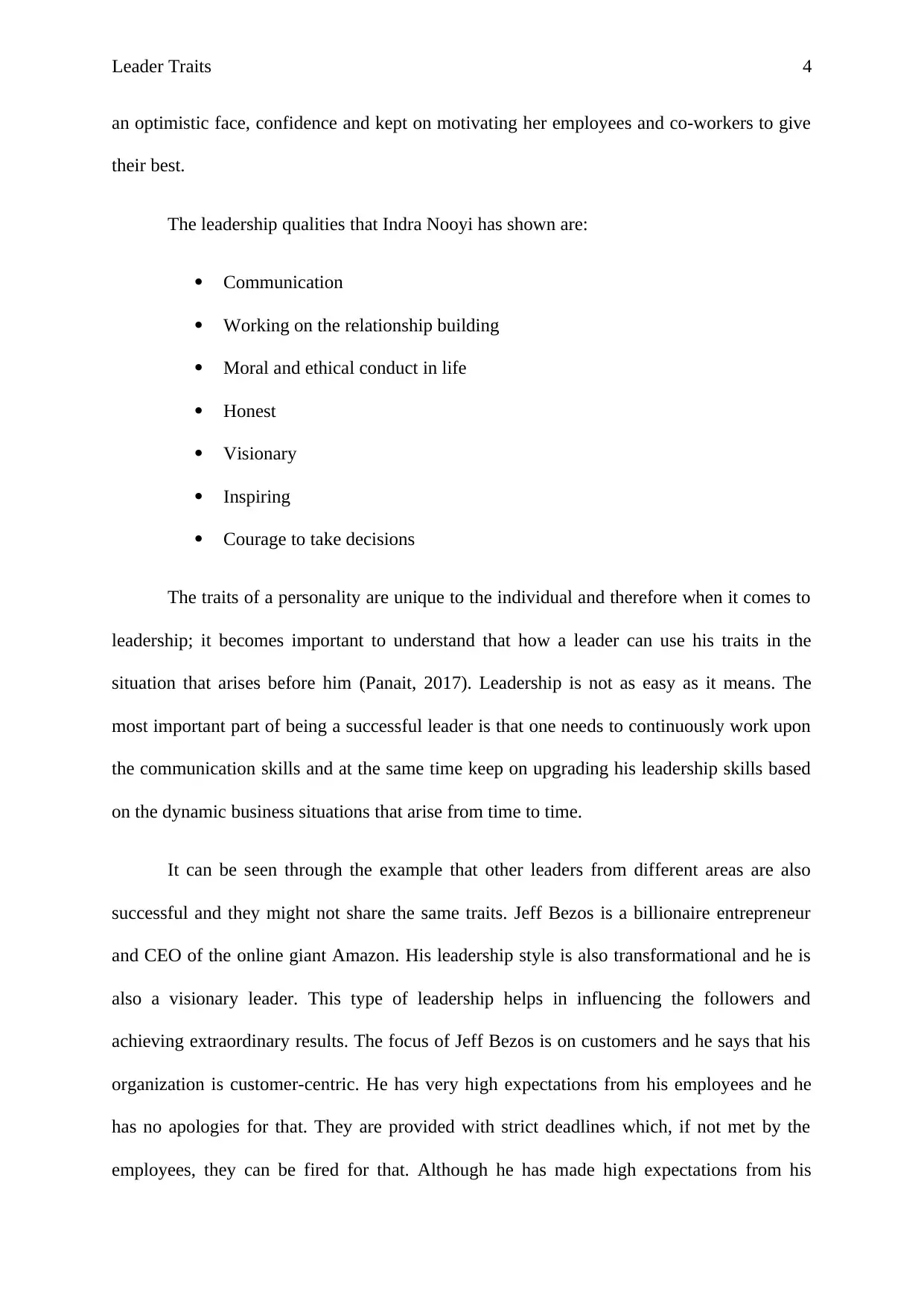
Leader Traits 4
an optimistic face, confidence and kept on motivating her employees and co-workers to give
their best.
The leadership qualities that Indra Nooyi has shown are:
Communication
Working on the relationship building
Moral and ethical conduct in life
Honest
Visionary
Inspiring
Courage to take decisions
The traits of a personality are unique to the individual and therefore when it comes to
leadership; it becomes important to understand that how a leader can use his traits in the
situation that arises before him (Panait, 2017). Leadership is not as easy as it means. The
most important part of being a successful leader is that one needs to continuously work upon
the communication skills and at the same time keep on upgrading his leadership skills based
on the dynamic business situations that arise from time to time.
It can be seen through the example that other leaders from different areas are also
successful and they might not share the same traits. Jeff Bezos is a billionaire entrepreneur
and CEO of the online giant Amazon. His leadership style is also transformational and he is
also a visionary leader. This type of leadership helps in influencing the followers and
achieving extraordinary results. The focus of Jeff Bezos is on customers and he says that his
organization is customer-centric. He has very high expectations from his employees and he
has no apologies for that. They are provided with strict deadlines which, if not met by the
employees, they can be fired for that. Although he has made high expectations from his
an optimistic face, confidence and kept on motivating her employees and co-workers to give
their best.
The leadership qualities that Indra Nooyi has shown are:
Communication
Working on the relationship building
Moral and ethical conduct in life
Honest
Visionary
Inspiring
Courage to take decisions
The traits of a personality are unique to the individual and therefore when it comes to
leadership; it becomes important to understand that how a leader can use his traits in the
situation that arises before him (Panait, 2017). Leadership is not as easy as it means. The
most important part of being a successful leader is that one needs to continuously work upon
the communication skills and at the same time keep on upgrading his leadership skills based
on the dynamic business situations that arise from time to time.
It can be seen through the example that other leaders from different areas are also
successful and they might not share the same traits. Jeff Bezos is a billionaire entrepreneur
and CEO of the online giant Amazon. His leadership style is also transformational and he is
also a visionary leader. This type of leadership helps in influencing the followers and
achieving extraordinary results. The focus of Jeff Bezos is on customers and he says that his
organization is customer-centric. He has very high expectations from his employees and he
has no apologies for that. They are provided with strict deadlines which, if not met by the
employees, they can be fired for that. Although he has made high expectations from his
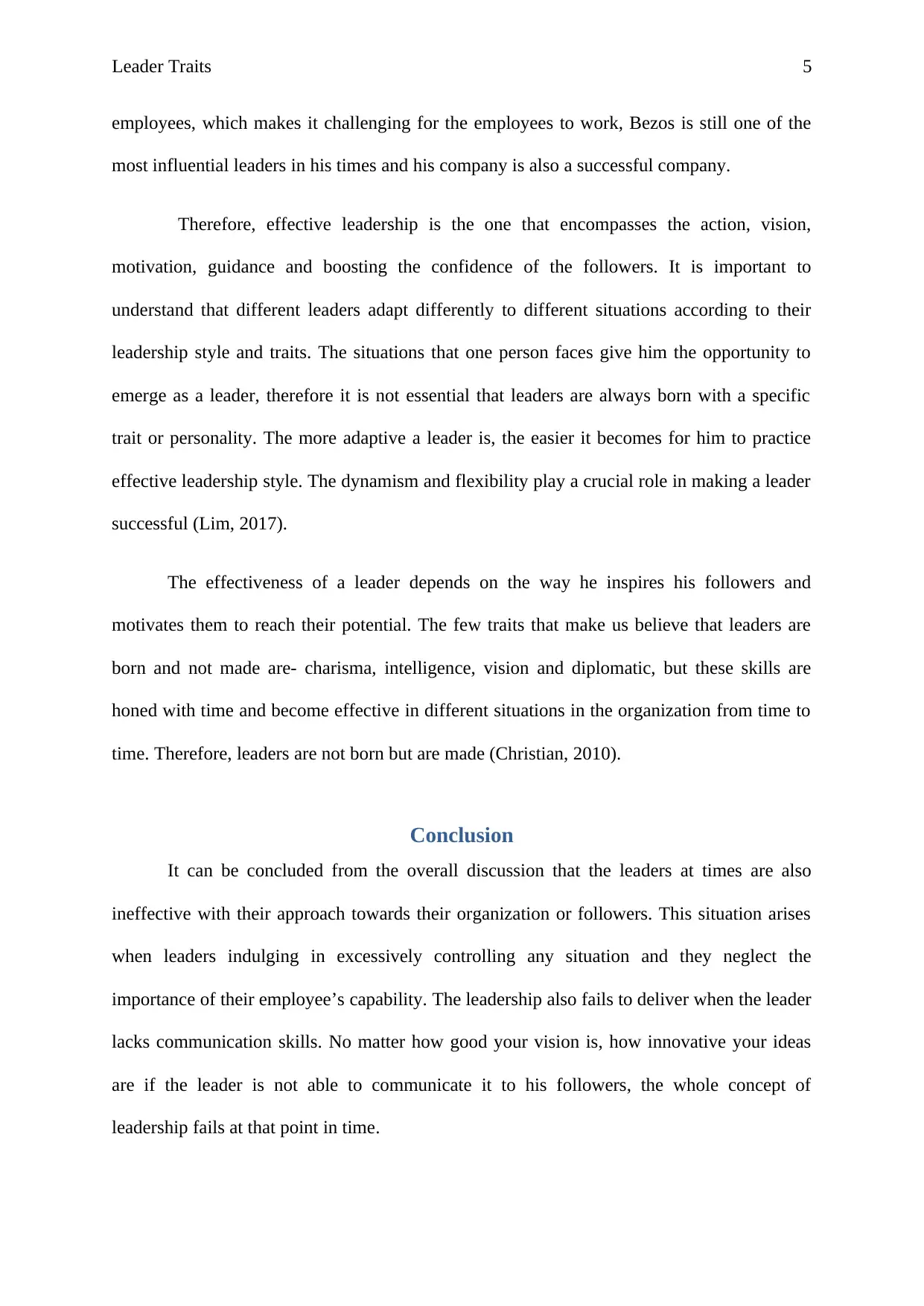
Leader Traits 5
employees, which makes it challenging for the employees to work, Bezos is still one of the
most influential leaders in his times and his company is also a successful company.
Therefore, effective leadership is the one that encompasses the action, vision,
motivation, guidance and boosting the confidence of the followers. It is important to
understand that different leaders adapt differently to different situations according to their
leadership style and traits. The situations that one person faces give him the opportunity to
emerge as a leader, therefore it is not essential that leaders are always born with a specific
trait or personality. The more adaptive a leader is, the easier it becomes for him to practice
effective leadership style. The dynamism and flexibility play a crucial role in making a leader
successful (Lim, 2017).
The effectiveness of a leader depends on the way he inspires his followers and
motivates them to reach their potential. The few traits that make us believe that leaders are
born and not made are- charisma, intelligence, vision and diplomatic, but these skills are
honed with time and become effective in different situations in the organization from time to
time. Therefore, leaders are not born but are made (Christian, 2010).
Conclusion
It can be concluded from the overall discussion that the leaders at times are also
ineffective with their approach towards their organization or followers. This situation arises
when leaders indulging in excessively controlling any situation and they neglect the
importance of their employee’s capability. The leadership also fails to deliver when the leader
lacks communication skills. No matter how good your vision is, how innovative your ideas
are if the leader is not able to communicate it to his followers, the whole concept of
leadership fails at that point in time.
employees, which makes it challenging for the employees to work, Bezos is still one of the
most influential leaders in his times and his company is also a successful company.
Therefore, effective leadership is the one that encompasses the action, vision,
motivation, guidance and boosting the confidence of the followers. It is important to
understand that different leaders adapt differently to different situations according to their
leadership style and traits. The situations that one person faces give him the opportunity to
emerge as a leader, therefore it is not essential that leaders are always born with a specific
trait or personality. The more adaptive a leader is, the easier it becomes for him to practice
effective leadership style. The dynamism and flexibility play a crucial role in making a leader
successful (Lim, 2017).
The effectiveness of a leader depends on the way he inspires his followers and
motivates them to reach their potential. The few traits that make us believe that leaders are
born and not made are- charisma, intelligence, vision and diplomatic, but these skills are
honed with time and become effective in different situations in the organization from time to
time. Therefore, leaders are not born but are made (Christian, 2010).
Conclusion
It can be concluded from the overall discussion that the leaders at times are also
ineffective with their approach towards their organization or followers. This situation arises
when leaders indulging in excessively controlling any situation and they neglect the
importance of their employee’s capability. The leadership also fails to deliver when the leader
lacks communication skills. No matter how good your vision is, how innovative your ideas
are if the leader is not able to communicate it to his followers, the whole concept of
leadership fails at that point in time.
⊘ This is a preview!⊘
Do you want full access?
Subscribe today to unlock all pages.

Trusted by 1+ million students worldwide
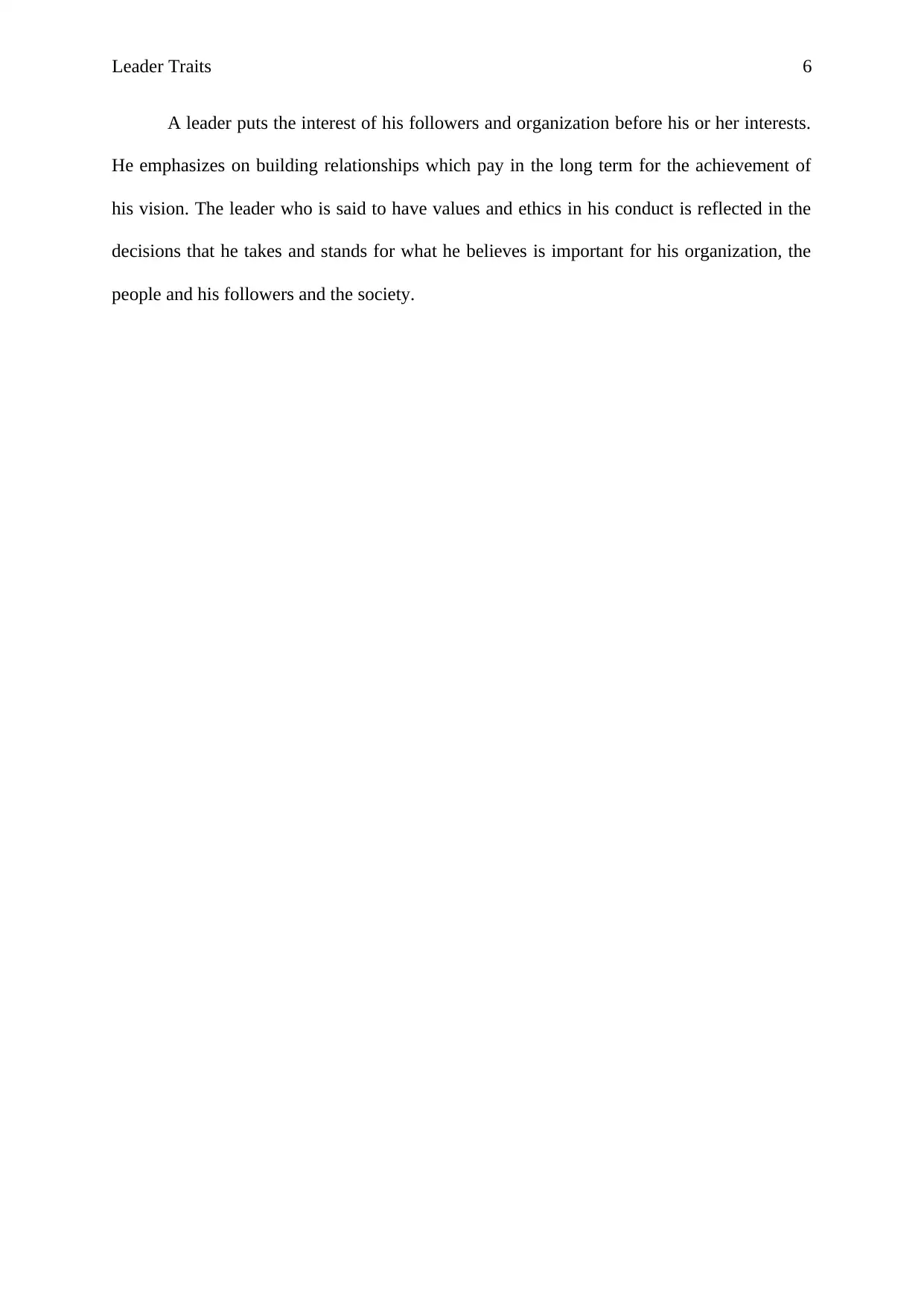
Leader Traits 6
A leader puts the interest of his followers and organization before his or her interests.
He emphasizes on building relationships which pay in the long term for the achievement of
his vision. The leader who is said to have values and ethics in his conduct is reflected in the
decisions that he takes and stands for what he believes is important for his organization, the
people and his followers and the society.
A leader puts the interest of his followers and organization before his or her interests.
He emphasizes on building relationships which pay in the long term for the achievement of
his vision. The leader who is said to have values and ethics in his conduct is reflected in the
decisions that he takes and stands for what he believes is important for his organization, the
people and his followers and the society.
Paraphrase This Document
Need a fresh take? Get an instant paraphrase of this document with our AI Paraphraser
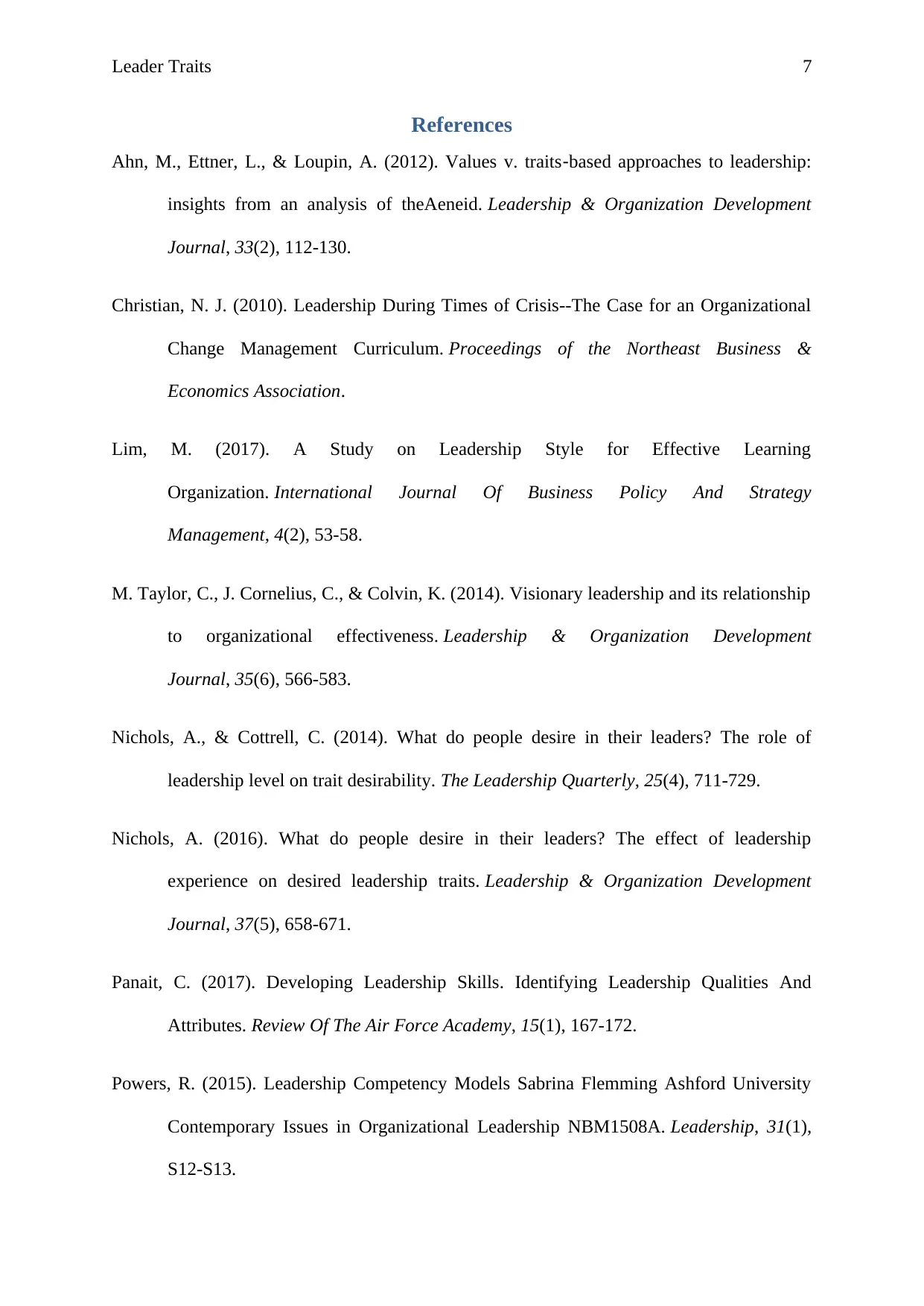
Leader Traits 7
References
Ahn, M., Ettner, L., & Loupin, A. (2012). Values v. traits‐based approaches to leadership:
insights from an analysis of theAeneid. Leadership & Organization Development
Journal, 33(2), 112-130.
Christian, N. J. (2010). Leadership During Times of Crisis--The Case for an Organizational
Change Management Curriculum. Proceedings of the Northeast Business &
Economics Association.
Lim, M. (2017). A Study on Leadership Style for Effective Learning
Organization. International Journal Of Business Policy And Strategy
Management, 4(2), 53-58.
M. Taylor, C., J. Cornelius, C., & Colvin, K. (2014). Visionary leadership and its relationship
to organizational effectiveness. Leadership & Organization Development
Journal, 35(6), 566-583.
Nichols, A., & Cottrell, C. (2014). What do people desire in their leaders? The role of
leadership level on trait desirability. The Leadership Quarterly, 25(4), 711-729.
Nichols, A. (2016). What do people desire in their leaders? The effect of leadership
experience on desired leadership traits. Leadership & Organization Development
Journal, 37(5), 658-671.
Panait, C. (2017). Developing Leadership Skills. Identifying Leadership Qualities And
Attributes. Review Of The Air Force Academy, 15(1), 167-172.
Powers, R. (2015). Leadership Competency Models Sabrina Flemming Ashford University
Contemporary Issues in Organizational Leadership NBM1508A. Leadership, 31(1),
S12-S13.
References
Ahn, M., Ettner, L., & Loupin, A. (2012). Values v. traits‐based approaches to leadership:
insights from an analysis of theAeneid. Leadership & Organization Development
Journal, 33(2), 112-130.
Christian, N. J. (2010). Leadership During Times of Crisis--The Case for an Organizational
Change Management Curriculum. Proceedings of the Northeast Business &
Economics Association.
Lim, M. (2017). A Study on Leadership Style for Effective Learning
Organization. International Journal Of Business Policy And Strategy
Management, 4(2), 53-58.
M. Taylor, C., J. Cornelius, C., & Colvin, K. (2014). Visionary leadership and its relationship
to organizational effectiveness. Leadership & Organization Development
Journal, 35(6), 566-583.
Nichols, A., & Cottrell, C. (2014). What do people desire in their leaders? The role of
leadership level on trait desirability. The Leadership Quarterly, 25(4), 711-729.
Nichols, A. (2016). What do people desire in their leaders? The effect of leadership
experience on desired leadership traits. Leadership & Organization Development
Journal, 37(5), 658-671.
Panait, C. (2017). Developing Leadership Skills. Identifying Leadership Qualities And
Attributes. Review Of The Air Force Academy, 15(1), 167-172.
Powers, R. (2015). Leadership Competency Models Sabrina Flemming Ashford University
Contemporary Issues in Organizational Leadership NBM1508A. Leadership, 31(1),
S12-S13.
1 out of 8
Related Documents
Your All-in-One AI-Powered Toolkit for Academic Success.
+13062052269
info@desklib.com
Available 24*7 on WhatsApp / Email
![[object Object]](/_next/static/media/star-bottom.7253800d.svg)
Unlock your academic potential
Copyright © 2020–2025 A2Z Services. All Rights Reserved. Developed and managed by ZUCOL.





